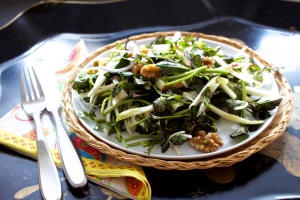 Note: Like radishes, watercress is one of the few crucifers that should be eaten raw.
Note: Like radishes, watercress is one of the few crucifers that should be eaten raw.
In this complex world of anti-cancer diets, some cruciferous vegetables may actually be more powerful than other fellow crucifers.
It all comes down to two words that begin with “I.”
The first: isothiocyanates (“eye-so-thigh-o-sigh-a-nates”), compounds that help remove carcinogens from your body. We know broccoli’s tops for sulforaphane; radishes for sulforaphene, both key isothiocyanates. And tiny broccoli and radish sprouts are even more potent than their mature vegetable counterparts.
But why AhR?
It’s linked to the second “I”: indoles, which help you get rid of harmful estrogens. But that’s not all they do, and for the full story, you need to dig deep into your gut.
Immunity begins in the gut, scientists often say. That’s because your intestines are filled with immune system cells along with trillions of microbes that work together, like an ecosystem, to help prevent–or, if not working well, promote– disease.
All the micro-organisms that live in your body are collectively called your microbiome, and many scientists think that we pick up the beginnings of our microbiome from our mother as we slide through the birth canal. From there on out, what you consume plays a major role.
Antibiotics, for example, kill off good as well as bad bacteria. Onions and mushrooms and other sources of pre-biotic fermentable fiber provide the raw material for making anti-inflammatory, disease-fighting bugs. And many polyphenols in plants also help produce beneficial microbes.
Within our guts, we all have aryl hydrocarbon receptors (AhR) that, when activated, turn on a slew of genes that help fortify the gut’s immune cells. In turn, those immune cells defend against bad bugs and help build and repair a very important body part–the lining of your intestines.
The Fence within your Gut
All that separates the contents of your gut from from your bloodstream is a thin lining of rapidly-dividing cells. And if that lining is damaged, then toxins, such as hormones and carcinogens that were trapped in fiber and heading for the toilet, can seep into your blood. The result? Your immune system, sensing something is wrong, launches an inflammatory attack.
Chemotherapy, which targets rapidly-dividing cells, damages your gut lining. So do saturated fats. But indole compounds from crucifers hold the key that activates those immune-enhancing receptors, thus strengthening the fence within your gut.
Just as with isothiocyanates, all crucifers are not equally rich in indoles.
Which Crucifers Help Repair the Fence?
To produce indoles, crucifers need a healthy supply of glucobrassicin (and/or related compounds.) Broccoli, cauliflower, kale and cabbage all contain a decent amount. Brussels sprouts have even more. And, according to this well-known study, the crucifer highest in glucobrassicin is watercress.
Its peppery bite is a clue to its potency. The kick comes from an enzyme that starts the process of turning glucobrassicin into indoles.
But there’s a catch. You need stomach acid to generate indoles. And if you’re among the many taking one of those popular pills to reduce stomach acid, then your indole production will be impaired. (Those pills were meant for short, not long term management of acid reflux.) To increase stomach acid, drink some lemon juice or apple cider vinegar a half hour before meals.
This is a perfect example of “Why you AhR what your body does with what you eat” may be the more apt generalization.
If you’re among the many with a type of cancer driven by estrogen, then indoles can help shift estrogen production away from the harmful metabolites of estrogen and towards more beneficial ones. If you’re among the many suffering from inflammatory bowel disease or psoriasis, an inflammatory skin condition, then indoles may also help.
Are you ready to sample the Jittery Cook’s simple indole-rich recipe for watercress salad? Hold the cheese, please–and throw in a few walnuts or pecans instead.
Thanks to Montreal’s Jittery Cook for her anti-cancer recipe and photo.

Pingback: L’Express Watercress Salad – Bistro Beauty
AWESOME !!! i ADORE watercress! wondering … does Arugula have a similar quality?
LikeLike
Arugula does have healthy isothiocyanates in the form of euricin. (Steam arugula to maximize those “I” compounds.) It doesn’t seem to be as rich as watercress in the other “I” word–indoles.
LikeLiked by 1 person
Pingback: #AICR19 Takeaway: Change Your Metabolism | Eat and Beat Cancer
Pingback: Anti-Cancer Strategies: Gut Microbes AhR Key to Controlling Inflammation | Eat and Beat Cancer